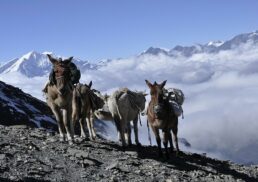Climbing the Seven Summits, also known as the challenge to climb 7 summits, is the ultimate mountaineering endeavor, involving the highest peak on each continent: Everest, Aconcagua, Denali, Kilimanjaro, Elbrus, Vinson Massif, and either Kosciuszko or Carstensz Pyramid. This guide will help you understand the essentials, from preparation to success stories, and the gear you need to join this elite group of climbers.
Table of Contents
Key Takeaways
The Seven Summits Challenge, comprising the highest peaks on each continent, is a prestigious goal for climbers of varying experience levels.
Training for the Seven Summits requires a focus on climbing-specific fitness, mental resilience, and gradual acclimatization to high altitudes.
Successful completion of the challenge can take from one to several years, heavily influenced by individual circumstances such as time and financial resources.
Climb 7 Summits: Essential Guide to Conquering the World’s Highest Peaks
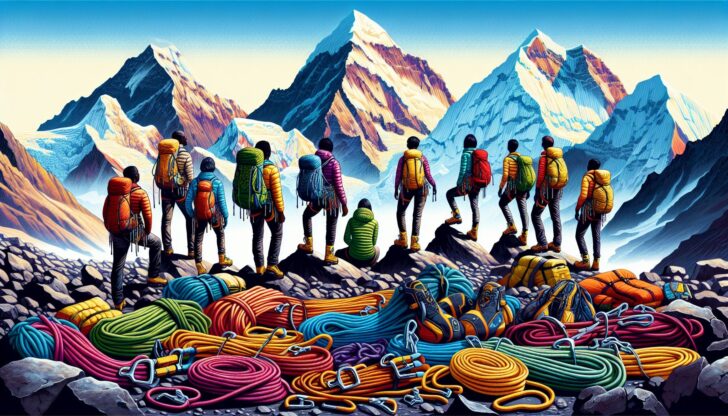
The Seven Summits Challenge involves climbing the highest peak on each of the seven continents. These peaks are Mount Everest (Asia), Aconcagua (South America), Denali (North America), Kilimanjaro (Africa), Mount Elbrus (Europe), Vinson Massif (Antarctica), and either Mount Kosciuszko or Carstensz Pyramid (Australia). The challenge is a prestigious milestone in mountaineering, attracting climbers from all around the globe.
Completing the Seven Summits often marks the pinnacle of a mountaineer’s career. Mountaineers typically begin with easier peaks, gradually moving to more challenging climbs to build experience. This method helps climbers develop essential skills and resilience for high-altitude climbing.
Completion times for the Seven Summits vary significantly, typically ranging from two to five years. Time availability, financial resources, and personal circumstances are crucial in determining the journey’s duration.
Training involves not only physical fitness but also mental resilience and dedication. It requires a focus on climbing-specific fitness rather than general workouts. For many, the challenge is a personal journey, pushing limits and discovering new strengths.
The Seven Summits Challenge offers an unparalleled adventure for both experienced mountaineers and novice climbers. It’s a journey that tests your limits, rewards perseverance, and provides an unforgettable experience on the highest peaks of the seven continents.
Introduction
Climbing the Seven Summits is more than just reaching the highest peak on each continent; it’s a transformative journey that takes you from being a novice climber to a skilled mountaineer. This adventure allows you to explore diverse regions of the world, each with its unique landscapes, cultures, and challenges.
As you progress through this guide, you will learn about the history of the Seven Summits Challenge, the necessary preparations, and the inspiring success stories of those who have completed it. This guide offers essential knowledge and skills for climbing Everest, Denali, Kilimanjaro, and other peaks in the Seven Summits challenge.
The Seven Summits Challenge
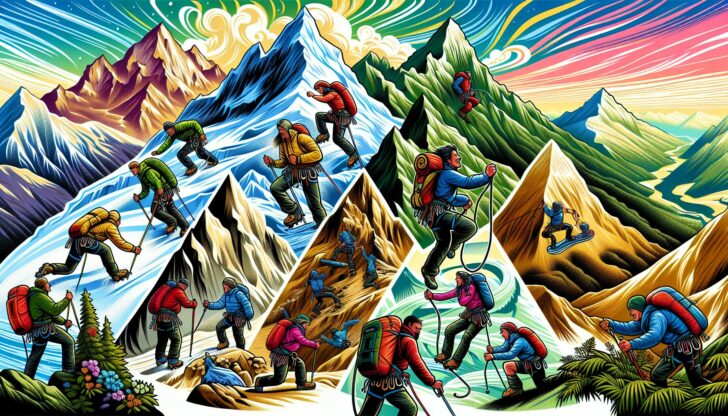
The Seven Summits are a prestigious milestone in mountaineering, attracting climbers worldwide. The challenge is accessible to climbers with varying experience levels, making it a popular goal for many. Most climbers begin their journey with less challenging peaks to build experience before tackling more difficult ascents. The seven summits consist of some of the highest peaks on each continent.
Training for the Seven Summits requires a focus on climbing-specific fitness rather than general workouts. It also demands mental resilience and dedication, as the journey can be long and arduous.
The challenge of completing the Seven Summits varies based on individual circumstances like time availability and financial resources.
History and Lists of the Seven Summits
The quest to climb all Seven Summits began in the 1980s and has gained immense popularity among climbers seeking new challenges. Richard Bass was the first to complete the Seven Summits challenge in 1985. Reinhold Messner followed in 1986, promoting a more rigorous standard by including Carstensz Pyramid over Mount Kosciuszko.
The two most recognized Seven Summits lists are Dick Bass’s, which includes Mount Kosciuszko, and Reinhold Messner’s, which features Carstensz Pyramid. The Bass list is often seen as more accessible, while the Messner list is considered more challenging.
Other variations of the Seven Summits list include peaks like Mount Vinson and the Seven Second Summits, referring to each continent’s second-highest mountain.
Bass vs. Messner Lists
The two most recognized lists of the Seven Summits are Dick Bass’s list, which includes Mount Kosciuszko, and Reinhold Messner’s list, which features Carstensz Pyramid. Carstensz Pyramid, at 4,884 meters (16,024 feet), is significantly more challenging than Mount Kosciuszko, which is an easier hike.
Including Carstensz Pyramid makes the Messner list more demanding, requiring technical climbing skills and an expedition-style approach to climb Carstensz Pyramid. Mount Kosciuszko, with its relatively easy hike, makes the Bass list more accessible to climbers of varying experience levels.
Other Notable Lists
Another notable list is the Seven Second Summits, which includes the second-highest peaks on each continent. This collection is a more challenging alternative to the standard Seven Summits due to the technical skills and varied conditions involved.
Christian Stangl was the first to complete the Seven Second Summits, highlighting its significant challenge. This alternative list appeals to mountaineers seeking a greater challenge beyond the traditional Seven Summits.
Preparation and Training for High Altitude Climbing
Achieving the Seven Summits allows individuals to advance from novice climbers to seasoned mountaineers while exploring various parts of the world. The journey is often transformative, encouraging personal growth and accomplishment. Such an endeavor requires a holistic approach, including coaching and planning from start to finish.
Climbers can develop essential skills on smaller peaks for larger expeditions. Training should include simulated climbing, long day hikes with elevation, and working with mountaineering coaches. Gradually ascending to higher elevations is crucial for effective acclimatization to reduced oxygen levels.
Acclimatization enhances comfort and endurance, improving overall performance at high altitudes. Pre-expedition training management includes resting several days before departure, avoiding overtraining, and considering jet lag effects.
Physical Fitness Requirements
Climbing training should simulate the actual conditions faced on expeditions. Courses should build specific mountaineering skills, particularly for cold and high-altitude conditions. Aerobic exercises like running, biking, and swimming are crucial for enhancing cardiovascular endurance for high-altitude climbs.
A rigorous training regimen, ideally five days a week, is essential. Gradually increasing distance and elevation during training helps adapt to the climb’s demands. Focus on long-duration hikes, preferably involving back-to-back climbing days. Aim for an ascent rate of 1,500 vertical feet per hour while carrying a day pack.
Mental Resilience
Comfort with long durations away from home, desire for rugged adventure, effective stress management, and teamwork are essential mental attributes for climbing the Seven Summits. Effective stress management techniques are vital for maintaining mental strength during high-altitude climbing challenges.
Teamwork and the ability to support and motivate fellow climbers are crucial for success. Mental resilience often separates those who succeed from those who fall short in this demanding challenge.
Recommended Training Courses
Consult a physician before starting any new training program to rule out health issues that could affect high-altitude activities. The Seven Summits training course emphasizes fundamental mountaineering tools and techniques.
AAI’s Seven Summits training course prepares climbers for climbs, focusing on cold, altitude, and expedition conditions. These structured courses are designed to progressively build the skills needed to tackle the Seven Summits.
Individual Summit Overviews
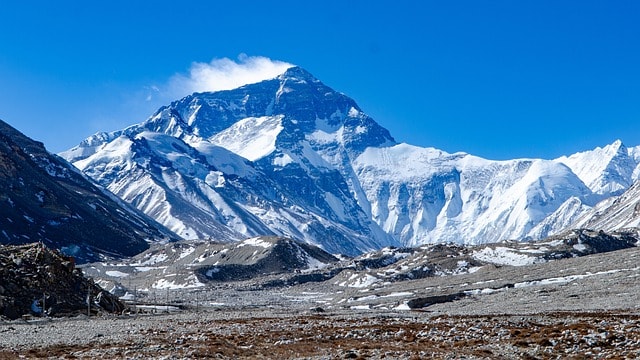
Achieving the Seven Summits is a significant personal milestone for many climbers, often described as transformative. Each summit presents unique challenges and requires different skills and preparations.
Below are overviews of each of the Seven Summits, highlighting their specific characteristics and what climbers can expect.
Asia: Mount Everest
Mount Everest, the highest peak in Asia, stands at 8,848.86 meters. The mountain has multiple climbing routes, with the Southern route being the most popular. The South Col and Northeast Ridge are key routes to summit Everest.
Climbers face severe weather, high altitudes, and frostbite risks on Everest. Extreme altitude sickness is a significant concern, making acclimatization and preparation crucial to those who wish to climb Everest.
Africa: Mount Kilimanjaro
Mount Kilimanjaro, the highest peak in Africa, stands at about 5,895 meters (19,340 feet). The mountain features three volcanic cones: Kibo, Mawenzi, and Shira, with Kibo as the highest. Kilimanjaro, one of the highest mountains, is also known as the tallest peak, offering multiple trekking routes for different skill levels and experiences.
Trekkers on Kilimanjaro can engage with local communities and learn about their rich traditions and culture. This cultural engagement adds a unique dimension to the climb, making it more than just a physical challenge.
North America: Denali
Denali, North America’s highest peak, reaches 6,190 meters (20,310 feet). The West Buttress route is the most commonly used path to summit Denali, known for its accessibility. Technical climbing routes on Denali require significant skills and high-altitude experience.
Climbers need advanced skills, including glacier travel and crevasse rescue, to climb Denali. Harsh weather conditions and challenging terrain make Denali a true test of a climber’s abilities.
Learn more, visit Denali | National Park, Height, Elevation, & Map.
South America: Aconcagua
Aconcagua stands at 22,842 feet (6,962 meters). AAI offers both non-technical and technical routes for Aconcagua. Aconcagua offers various trekking routes, including the frequently used Normal Route.
Climbing Aconcagua is a significant achievement, providing a taste of high-altitude conditions and preparing climbers for more challenging ascents.
Antarctica: Vinson Massif
Vinson Massif, the highest peak in Antarctica, stands at about 16,050 feet (4,892 meters). Climbing Vinson Massif presents challenges due to extreme cold and remoteness. The harsh environment requires climbers to be well-prepared and resilient.
Europe: Mount Elbrus
Mount Elbrus, located in the Caucasus region of Russia, is Europe’s highest peak, standing at 5,642 meters (18,510 feet). Climbing difficulty varies, but Mount Elbrus generally requires only basic alpine skills due to its less technical routes.
The Caucasus region, home to Mount Elbrus, is known for its rich cultural heritage and diverse ethnic groups. Climbing Elbrus offers not only a mountaineering challenge but also an opportunity to explore the unique cultural landscape of the caucasus mountains.
Australia: Mount Kosciuszko or Carstensz Pyramid
Mount Kosciuszko, the highest peak in Australia, has an elevation of 2,228 meters (7,310 feet). Carstensz Pyramid, an alternative to Mount Kosciuszko, stands at 4,884 meters (16,024 feet). The debate between climbing Mount Kosciuszko or Carstensz Pyramid revolves around which peak should represent Australia’s Seven Summits.
The Bass list includes Mount Kosciuszko as the highest peak in Australia, while the Messner list features Puncak Jaya (Carstensz Pyramid). Carstensz Pyramid, significantly taller and more challenging, is favored by those seeking a more demanding climb.
Strategic Progression and Climbing Order
The Seven Summits challenge is structured to provide a natural progression in climbing skills, making it accessible for various levels of climbers. Many climbers choose a progressive approach, starting with easier peaks like Kilimanjaro, followed by Mt. Elbrus and Aconcagua, before advancing to more challenging climbs.
Individual situations, such as time and financial constraints, influence the climbing order for the Seven Summits. More experienced climbers usually group climbs by region and leverage past climbs for training.
Costs and Logistics of Climbing the Seven Summits
Completing the Seven Summits offers a personal challenge that varies based on individual circumstances such as time and finances. Financial investment for climbing the Seven Summits can start at approximately $135,000, not including additional expenses.
Successful completion of the Seven Summits challenge is supported by expert guides and comprehensive logistics, ensuring safety and success for climbers. The journey to completing the Seven Summits can vary significantly in duration, ranging from one year to several years.
Estimated Costs
The starting budget for climbing the Seven Summits is around $135,000. Mount Elbrus typically costs between $1,500 for basic support and over $4,000 for luxury options. Vinson’s climbing costs range from $45,000 to over $55,000, reflecting its remote and challenging environment.
Climbing Mount Everest can cost between $35,000 to over $70,000, depending on the level of support and amenities chosen. Other peaks like Aconcagua, Denali, and Kilimanjaro also have varying costs based on the level of support and logistics required.
Gear and Equipment
High-altitude climbing demands specialized gear to ensure safety, comfort, and success. Essential gear includes:
Insulated jackets
Thermal layers
Mountaineering boots
Climbing hardware
Recommended brands for insulated jackets are The North Face and Patagonia; for mountaineering boots, consider Scarpa and La Sportiva.
Choosing high-quality gear is crucial as it can greatly impact your climbing experience and safety. Investing in reliable equipment is essential for tackling the diverse and challenging conditions of the Seven Summits.
Planning and Booking Expeditions
The guides for climbing the Seven Summits are required to be qualified, tenured, tested, and personable to ensure safety and a positive experience. Each expedition related to climbing the Seven Summits is personally overseen by Mike Hamill to manage the logistical challenges effectively.
Planning and booking expeditions with professional support allows climbers to focus on their preparation and training, ensuring a more enjoyable and successful journey. Guided expeditions offer the expertise and logistical support needed to tackle the world’s highest peaks.
Safety Considerations for High Altitude Climbing
Training programs focusing on high-altitude conditions often emphasize acclimatization and understanding the impacts of altitude on the body. Medications such as acetazolamide can aid in quicker acclimatization and help treat symptoms of acute mountain sickness.
Travelers should avoid ascending to sleep at higher elevations if experiencing any symptoms of altitude sickness. In cases of worsening symptoms at the same elevation, it is crucial to descend to prevent severe altitude-related illnesses. Emergency protocols recommend having a pressurization bag to simulate descent when immediate descent is not possible.
Success Stories and Inspirational Climbers
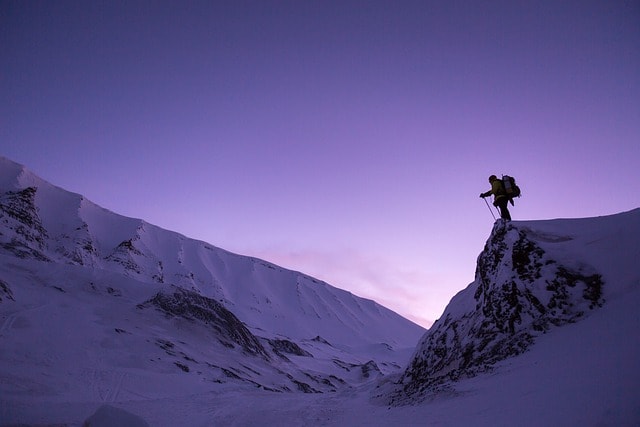
Richard Bass was the first climber to reach the summit of all seven highest peaks on the continents, completing this feat on April 30, 1985. Reinhold Messner completed his ascent of the Seven Summits in 1986, making significant contributions to mountaineering. Junko Tabei was the first woman to complete the Seven Summits in 1992, breaking barriers for female climbers.
Colin O’Brady set a record by completing the Seven Summits in just 131 days, achieving both the Bass and Messner lists. Vanessa O’Brien set a record for the fastest female ascent of the Seven Summits, completing the challenge in 10 months. In January 2010, Carlos Soria Fontán finished the Seven Summits at the age of 71, demonstrating remarkable endurance.
Arunima Sinha became the first female amputee to conquer the Seven Summits, achieving this feat in January 2019. Tashi and Nungshi Malik made history as the first twins to complete the Seven Summits in December 2014. In 2018, Chris Bombardier became the first person with hemophilia to complete the Seven Summits.
Summary
The Seven Summits Challenge is a remarkable journey that tests the limits of human endurance and determination. From the icy slopes of Everest to the volcanic cones of Kilimanjaro, each peak offers a unique adventure. By following the guidance and preparation outlined in this guide, you can embark on your own journey to complete the Seven Summits and join the ranks of the world’s most accomplished mountaineers.
Frequently Asked Questions
What is the Seven Summits Challenge?
The Seven Summits Challenge is an ambitious goal of climbing the highest mountain on each of the seven continents, demonstrating significant mountaineering skill and endurance. Completing this challenge is a notable achievement in the climbing community.
How long does it typically take to complete the Seven Summits?
It typically takes climbers between two to five years to complete the Seven Summits, influenced by individual circumstances like time and financial resources.
What are the main differences between the Bass and Messner lists?
The main difference between the Bass and Messner lists is that the Bass list includes Mount Kosciuszko as Australia’s highest peak, whereas the Messner list recognizes Carstensz Pyramid, which demands more technical climbing skills. This distinction highlights the varying criteria for what constitutes the highest peaks in a region.
What are the estimated costs for climbing the Seven Summits?
Climbing the Seven Summits typically involves a starting budget of approximately $135,000, excluding any additional expenses. Costs can vary significantly based on the level of support and logistics needed for each ascent.
What type of training is required for the Seven Summits?
To successfully tackle the Seven Summits, you need to focus on climbing-specific fitness, mental resilience, and high-altitude acclimatization. Engaging in structured training programs and seeking professional guidance is highly advisable.


